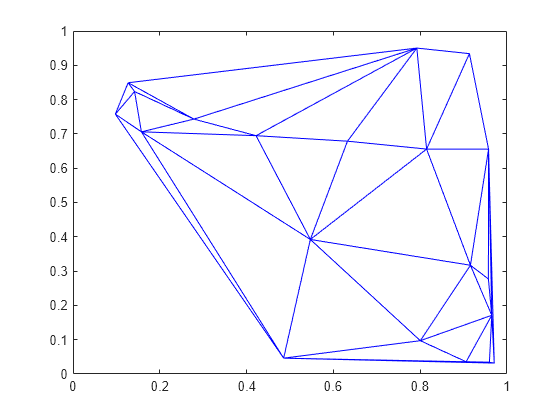DelaunayTri
(Not recommended) Delaunay triangulation in 2-D and 3-D
DelaunayTri is not recommended. Use delaunayTriangulation instead.
Description
DelaunayTri creates a Delaunay triangulation object from a
set of points. You can incrementally modify the triangulation by adding or removing points. In
2-D triangulations you can impose edge constraints. You can perform topological and geometric
queries, and compute the Voronoi diagram and convex hull.
Creation
Syntax
Description
DT = DelaunayTri
DT = DelaunayTri(X)DT = DelaunayTri(x,y)DT
= DelaunayTri(x,y,z)mpts-by-ndim matrix X, where
mpts is the number of points and ndim is the
dimension of the space where the points reside (ndim is 2 or 3).
Alternatively, the points can be specified as column vectors (x,y) or
(x,y,z) for 2-D and 3-D input.
DT = DelaunayTri(___,C)
Input Arguments
Properties
Object Functions
In addition to the below object functions, DelaunayTri
objects support indexing into the triangulation using parentheses (). The
syntax is the same as for arrays.
baryToCart | (Not recommended) Convert point coordinates from barycentric to Cartesian |
cartToBary | (Not recommended) Convert point coordinates from Cartesian to barycentric |
circumcenters | (Not recommended) Circumcenters of specified simplices |
convexHull | (Not recommended) Convex hull of Delaunay triangulation |
edgeAttachments | (Not recommended) Triangles or tetrahedra attached to specified edge |
edges | (Not recommended) Triangulation edges |
faceNormals | (Not recommended) Unit normals to specified triangles |
featureEdges | (Not recommended) Sharp edges of surface triangulation |
freeBoundary | (Not recommended) Free boundary facets |
incenters | (Not recommended) Incenters of specified simplices |
inOutStatus | (Not recommended) Status of triangles in 2-D constrained Delaunay triangulation |
isEdge | (Not recommended) Test if vertices are joined by edge |
nearestNeighbor | (Not recommended) Vertex closest to specified point |
neighbors | (Not recommended) Triangle or tetrahedron neighbors |
pointLocation | (Not recommended) Triangle or tetrahedron enclosing point |
size | (Not recommended) Size of triangulation matrix |
vertexAttachments | (Not recommended) Triangles or tetrahedra attached to vertex |
voronoiDiagram | (Not recommended) Voronoi diagram of Delaunay triangulation |
Examples
More About
Tips
DelaunayTrican produce incorrect or inconsistent results when boundary constraints intersect or overlap. To avoid this behavior, use constraints that form one or multiple closed boundaries that do not intersect or overlap.
Version History
Introduced in R2009a
See Also
triangulation | delaunayTriangulation | scatteredInterpolant
